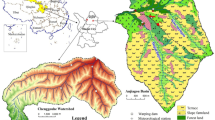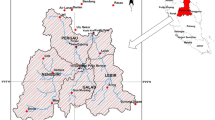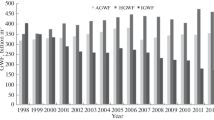Abstract
The grey water footprint (GWF) is an advanced index linking pollution load and water resources. However, the existing agriculture-related GWF was developed based on hydrological processes, which limits its role in watershed water pollution level (WPL) measurements. The main scope of this study is to calculate GWF and WPL based on runoff, total nitrogen (TN), and total phosphorus (TP) observations in the Hujiashan Watershed of China’s Yangtze River Basin. Partial least squares structural equation modeling (PLS-SEM) was utilized to explore the impact pathways of environmental features on GWF and WPL. On this basis, propose measures for the management of this agricultural watershed. The results showed that the TN concentration had a V-shaped trend in 2008–2015, while the TP gradually decreased. The GWF calculations for the TN and TP were compatible with the temporal trends for the concentrations, which were higher in the wet season (0.45 m3/m2 for TN, 0.10 m3/m2 for TP) than in the dry season (0.11 m3/m2 for TN, 0.02 m3/m2 for TP) and increased from upstream to downstream. The WPLs of TN exceeded 2.0 in the midstream and downstream areas, whereas those for TP were inconspicuous. According to PLS-SEM, the GWF is primarily influenced by topographical variables and hydrological features, whereas the WPL is mainly controlled by hydrological features and landscape composition. Fertilizer reduction and efficiency measures should be implemented on farmland and appropriately reducing farming activities on slopes to relieve the GWF and WPL in the watershed.








Similar content being viewed by others
Data availability
The datasets used or analyzed during the current study are available from the corresponding author on reasonable request.
References
Aldaya MM, Chapagain AK, Hoekstra AY, Mekonnen MM (2012) The water footprint assessment manual: setting the global standard. Routledge
An M, Xie P, He W, Wang B, Huang J, Khanal R (2023) Local and tele-coupling development between carbon emission and ecologic environment quality. J Clean Prod 394:136409
Billy C, Birgand F, Ansart P, Peschard J, Sebilo M, Tournebize J (2013) Factors controlling nitrate concentrations in surface waters of an artificially drained agricultural watershed. Landscape Ecol 28:665–684
Boardman E, Danesh-Yazdi M, Foufoula-Georgiou E, Dolph CL, Finlay JC (2019) Fertilizer, landscape features and climate regulate phosphorus retention and river export in diverse Midwestern watersheds. Biogeochemistry 146:293–309
Cao X, Zeng W, Wu M, Guo X, Wang W (2020) Hybrid analytical framework for regional agricultural water resource utilization and efficiency evaluation. Agric Water Manage 231:106027
Cao XR, Cyuzuzo CM, Saiken A, Song B (2021) A linear additivity water resources assessment indicator by combining water quantity and water quality. Ecol Indic 121:106990
Cao X, Bao Y, Li Y, Li J, Wu M (2023) Unravelling the effects of crop blue, green and grey virtual water flows on regional agricultural water footprint and scarcity. Agric Water Manage 278:108165
Cui S, Wu M, Huang X, Wang X, Cao X (2022) Sustainability and assessment of factors driving the water-energy-food nexus in pumped irrigation systems. Agric Water Manage 272:107846
Dai XY, Zhou YQ, Ma WC, Zhou LG (2017) Influence of spatial variation in land-use patterns and topography on water quality of the rivers inflowing to Fuxian Lake, a large deep lake in the plateau of southwestern China. Ecol Eng 99:417–428
Franke N, Boyacioglu H, Hoekstra AY (2013) Grey water footprint accounting: tier 1 supporting guidelines, 65. Unesco-Ihe Delft, The Netherlands
Fu TB, Xu CX, Yang LH, Hou SY, Xia Q (2022) Measurement and driving factors of grey water footprint efficiency in Yangtze River Basin. Sci Total Environ 802:149587
Goyette JO, Bennett EM, Maranger R (2019) Differential influence of landscape features and climate on nitrogen and phosphorus transport throughout the watershed. Biogeochemistry 142:155–174
Henseler J, Ringle CM, Sinkovics RR (2009) The use of partial least squares path modeling in international marketing. In: Sinkovics RR, Ghauri PN (eds) New Challenges to International Marketing. Emerald Group Publishing Limited, Advances in International Marketing, pp 277–319
Hoekstra AY, Mekonnen MM (2012a) The water footprint of humanity. Proc Natl Acad Sci 109:3232–3237
Hoekstra AY, Mekonnen MM (2012b) The water footprint of humanity. Proc Natl Acad Sci U S A 109:3232–3237
Hoekstra AY, Chapagain AK, Aldaya MM, Mekonnen MM (2011) The water footprint assessment manual: setting the global standard. Routledge
Huang JC, Lee TY, Kao SJ, Hsu SC, Lin HJ, Peng TR (2012) Land use effect and hydrological control on nitrate yield in subtropical mountainous watersheds. Hydrol Earth Syst Sci 16:699–714
Jiang SY, Zhang Q, Werner AD, Wellen C, Hu P, Sun JH, Deng YQ, Rode M (2020) Modelling the impact of runoff generation on agricultural and urban phosphorus loading of the subtropical Poyang Lake (China). J Hydrol 590:125490
Khatri N, Tyagi S (2015) Influences of natural and anthropogenic factors on surface and groundwater quality in rural and urban areas. Front Life Sci 8:23–39
Kibena J, Nhapi I, Gumindoga W (2014) Assessing the relationship between water quality parameters and changes in landuse patterns in the Upper Manyame River. Zimbabwe Phys Chem Earth 67–69:153–163
Kong Y, He W, Zhang Z, Shen J, Yuan L, Gao X, An M, Ramsey TS (2022) Spatial-temporal variation and driving factors decomposition of agricultural grey water footprint in China. J Environ Manage 318:115601
Li W, An M, Wu H, An H, Huang J, Khanal R (2023) The local coupling and telecoupling of urbanization and ecological environment quality based on multisource remote sensing data. J Environ Manage 327:116921
Lionetto MG, Caricato R, Calisi A, Giordano ME, Erroi E, Schettino T (2016) Biomonitoring of water and soil quality: a case study of ecotoxicological methodology application to the assessment of reclaimed agroindustrial wastewaters used for irrigation. Rend Lincei-Sci Fis Nat 27:105–112
Liu C, Kroeze C, Hoekstra AY, Gerbens-Leenes W (2012) Past and future trends in grey water footprints of anthropogenic nitrogen and phosphorus inputs to major world rivers. Ecol Indic 18:42–49
Liu W, Tian S, Youssef MA, Birgand FP, Chescheir GM (2022) Patterns of long-term variations of nitrate concentration–stream discharge relationships for a drained agricultural watershed in Mid-western USA. J Hydrol 614:128479
Lkr A, Singh M, Puro N (2020) Assessment of water quality status of Doyang river, Nagaland, India, using water quality index. Appl Water Sci 10:1–13
Lovarelli D, Bacenetti J, Fiala M (2016) Water footprint of crop productions: a review. Sci Total Environ 548:236–251
McGarigal K, Cushman SA, Ene E (2012) Spatial pattern analysis program for categorical and continuous maps. Computer software program produced by the authors at the University of Massachusetts, Amherst. FRAGSTATS v4.
McGuire KJ, McDonnell JJ, Weiler M, Kendall C, McGlynn BL, Welker JM, Seibert J (2005) The role of topography on catchment-scale water residence time. Water Resour. Res. 41
Mekonnen MM, Hoekstra AY (2015) Global gray water footprint and water pollution levels related to anthropogenic nitrogen loads to fresh water. Environ Sci Technol 49:12860–12868
Meng C, Liu HY, Li YY, Shen JL, Li X, Deng Y, Gong DL, Wu JS (2022) Influence path identification of topography, soil, hydrology and landscape on phosphorus buffering capacity in typical agricultural catchments in central subtropical China. J Environ Manage 315:115164
Molenat J, Gascuel-Odoux C, Ruiz L, Gruau G (2008) Role of water table dynamics on stream nitrate export and concentration. in agricultural headwater catchment (France). J Hydrol 348:363–378
Moriasi DN, Arnold JG, Van Liew MW, Bingner RL, Harmel RD, Veith TL (2007) Model evaluation guidelines for systematic quantification of accuracy in watershed simulations. Trans ASABE 50:885–900
Muratoglu A (2020) Grey water footprint of agricultural production: an assessment based on nitrogen surplus and high-resolution leaching runoff fractions in Turkey. Sci Total Environ 742:140553
Ning TT, Li Z, Feng Q, Chen W, Li ZX (2020) Effects of forest cover change on catchment evapotranspiration variation in China. Hydrol Process 34:2219–2228
Novoa V, Ahumada-Rudolph R, Rojas O, Munizag J, Saez K, Arumi JL (2019) Sustainability assessment of the agricultural water footprint in the Cachapoal River basin. Chile Ecol Indic 98:19–28
Ongley ED, Zhang XL, Yu T (2010) Current status of agricultural and rural non-point source pollution assessment in China. Environ Pollut 158:1159–1168
Paredes-Arquiola J, Andreu-Alvarez J, Martin-Monerris M, Solera A (2010) Water quantity and quality models applied to the Jucar River Basin. Spain Water Resour Manage 24:2759–2779
Pearl J (2012) The causal mediation formula-a guide to the assessment of pathways and mechanisms. Prev Sci 13:426–436
Peng SY, Li SH (2021) Scale relationship between landscape pattern and water quality in different pollution source areas: a case study of the Fuxian Lake watershed. China Ecol Indic 121:107136
Salhi A, Benabdelouahab S, Bouayad E, Benabdelouahab T, Larifi I, El Mousaoui M, Acharrat N, Himi M, Ponsati AC (2021) Impacts and social implications of landuse-environment conflicts in a typical Mediterranean watershed. Sci Total Environ 764:142853
Sarstedt M, Ringle CM, Hair JF (2017) Treating unobserved heterogeneity in PLS-SEM: a multi-method approach, partial least squares path modeling. Springer, 197–217
Shi ZH, Ai L, Li X, Huang XD, Wu GL, Liao W (2013) Partial least-squares regression for linking land-cover patterns to soil erosion and sediment yield in watersheds. J Hydrol 498:165–176
Sliva L, Williams DD (2001) Buffer zone versus whole catchment approaches to studying land use impact on river water quality. Water Res 35:3462–3472
Sun Q, Huang J, Hong H, Li Q, Lin J, Feng Y (2011) Analysis on linkage between farm landscape and water quality in Jiulong River watershed. Nongye Gongcheng Xuebao 27:54–59
Tan S, Zhao G, Peng C, Ye W, Xie D, Chen F, Ni C, Shao J, Zheng L, Ni J (2023) Multi-scale effects of landscape on nitrogen (N) and phosphorus (P) in a subtropical agricultural watershed: a case of Qi river basin (QRB). China Ecol Indic 147:110017
Tian YT, Li CH, Yi YJ, Wang X, Shu AP (2020) Dynamic model of a sustainable water resources utilization system with coupled water quality and quantity in Tianjin City. Sustainability 12:4254
van der Walt K (2008) Globalization of water: sharing the planet’s freshwater resources. S Afr Geogr J 90:147–147
Varekar V, Yadav V, Karmakar S (2021) Rationalization of water quality monitoring locations under spatiotemporal heterogeneity of diffuse pollution using seasonal export coefficient. J Environ Manage 277:111342
Wang Y, Zhang J, Chen G, Shan Q, Li Z, Xu Y, Chen Y (2012) Responses of water quality to landscape pattern in Taihu watershed: case study of 3 typical streams in Yixing. Shengtai Xuebao 32:6422–6430
Wang Y, Yang J, Liang J, Qiang Y, Fang S, Gao M, Fan X, Yang G, Zhang B, Feng Y (2018) Analysis of the environmental behavior of farmers for non-point source pollution control and management in a water source protection area in China. Sci Total Environ 633:1126–1135
Wang Y, Liang J, Yang J, Ma X, Li X, Wu J, Yang G, Ren G, Feng Y (2019) Analysis of the environmental behavior of farmers for non-point source pollution control and management: an integration of the theory of planned behavior and the protection motivation theory. J Environ Manage 237:15–23
Wang S, Wang Y, Wang Y, Wang Z (2022) Assessment of influencing factors on non-point source pollution critical source areas in an agricultural watershed. Ecol Indic 141:109084
Wu M, Cao X, Guo X, Xiao J, Ren J (2021) Assessment of grey water footprint in paddy rice cultivation: effects of field water management policies. J Clean Prod 313:127876
Xiao R, Wang GF, Zhang QW, Zhang ZH (2016) Multi-scale analysis of relationship between landscape pattern and urban river water quality in different seasons. Sci, Rep, p 6
Xu HS, Xu ZX, Wu W, Tang FF (2012) Assessment and spatiotemporal variation analysis of water quality in the Zhangweinan River Basin, China, 18TH BIENNIAL ISEM CONFERENCE ON ECOLOGICAL MODELLING FOR GLOBAL CHANGE AND COUPLED HUMAN AND NATURAL SYSTEM, 1641–1652
Yang J, Xu Y, Gao B, Wang Y, Xu Y, Ma Q (2017) River water quality change and its relationship with landscape pattern under the urbanization:a case study of Suzhou City in Taihu Basin. J Lake Sci 29:827–835
Zeng Z, Luo W-G, Wang Z, Yi F-C (2021) Water pollution and its causes in the Tuojiang River Basin, China: an artificial neural network analysis. Sustainability 13:792
Zhang M-K, Wang L-P, He Z-L (2007) Spatial and temporal variation of nitrogen exported by runoff from sandy agricultural soils. J Environ Sci 19:1086–1092
Zhang FS, Cui ZL, Fan MS, Zhang WF, Chen XP, Jiang RF (2011) Integrated soil-crop system management: reducing environmental risk while increasing crop productivity and improving nutrient use efficiency in China. J Environ Qual 40:1051–1057
Zhang L, Dong H, Geng Y, Francisco M-J (2019) China’s provincial grey water footprint characteristic and driving forces. Sci Total Environ 677:427–435
Zhao X, Zhou Y, Min J, Wang SQ, Shi WM, Xing GX (2012) Nitrogen runoff dominates water nitrogen pollution from rice-wheat rotation in the Taihu Lake region of China. Agric Ecosyst Environ 156:1–11
Zhao DD, Tang Y, Liu JG, Tillotson MR (2017) Water footprint of Jing-Jin-Ji urban agglomeration in China. J Clean Prod 167:919–928
Zhou Y, Xu JF, Yin W, Ai L, Fang NF, Tan WF, Yan FL, Shi ZH (2017) Hydrological and environmental controls of the stream nitrate concentration and flux in a small agricultural watershed. J Hydrol 545:355–366
Funding
This work is jointly funded by the National Natural Science Foundation of China (52309049), the Natural Science Foundation of Jiangsu Province (BK20221504, BK20230969), the Fundamental Research Funds for the Central Universities (B230201009), Jiangsu Funding Program for Excellent Postdoctoral Talent and ‘Qinglan Project’ of Jiangsu Province.
Author information
Authors and Affiliations
Contributions
Xinyu Gao and Xinchun Cao contributed to the conception of the study; Liting Qiu, Xuang Huang, and Mengyang Wu contributed significantly to analyze and manuscript preparation; Xinyu Gao, Mengyang Wu, and Xinchun Cao performed the data analyses and wrote the manuscript. All authors read and approved the final manuscript.
Corresponding author
Ethics declarations
Ethical approval
Not applicable.
Consent to participate
Not applicable.
Consent for publication
Not applicable.
Competing interests
The authors declare no competing interests.
Additional information
Responsible Editor: Xianliang Yi
Publisher's Note
Springer Nature remains neutral with regard to jurisdictional claims in published maps and institutional affiliations.
Rights and permissions
Springer Nature or its licensor (e.g. a society or other partner) holds exclusive rights to this article under a publishing agreement with the author(s) or other rightsholder(s); author self-archiving of the accepted manuscript version of this article is solely governed by the terms of such publishing agreement and applicable law.
About this article
Cite this article
Gao, X., Qiu, L., Huang, X. et al. Monitoring grey water footprint and associated environmental controls in agricultural watershed. Environ Sci Pollut Res 31, 11334–11348 (2024). https://doi.org/10.1007/s11356-024-31961-7
Received:
Accepted:
Published:
Issue Date:
DOI: https://doi.org/10.1007/s11356-024-31961-7




